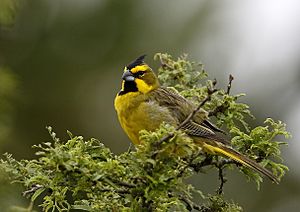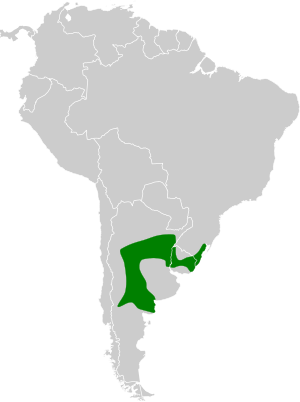Yellow cardinal facts for kids
The yellow cardinal (Gubernatrix cristata) is a special kind of bird from South America. It belongs to the tanager family. This bird is the only member of its group, called Gubernatrix. It's very rare and can only be found on one continent.
Quick facts for kids Yellow cardinal |
|
|---|---|
 |
|
| Conservation status | |
| Scientific classification | |
| Genus: |
Gubernatrix
|
| Species: |
cristata
|
 |
|
About Its Name and Family
The yellow cardinal was officially named in 1817 by a French bird expert named Louis Jean Pierre Vieillot. He gave it the scientific name Coccothraustes cristata. The word cristata comes from Latin and means "crested" or "plumed," which describes its feathery crest.
Later, in 1837, another French expert, René Lesson, moved the bird into its own special group, or genus, called Gubernatrix. This genus name is a Latin word meaning "governess."
For a long time, people thought the yellow cardinal was part of the sparrow family. But in 2011, a study showed it was actually more closely related to the tanager family. Another big study in 2014 strongly suggested that the yellow cardinal is a "sister" species to the diuca finch. This means they are very closely related. The yellow cardinal is a single species, meaning there are no different types or subspecies of it.
Where Does It Live?
You can find the yellow cardinal in several South American countries: Argentina, Brazil, Paraguay, and Uruguay.
It likes to live in places like dry savannas, temperate shrublands, and warm, wet shrublands. It also lives in temperate grasslands.
Sadly, this bird is in danger. Its homes are disappearing because of human activities. Also, many yellow cardinals are caught by people who want to sell them as pets. Male birds are especially targeted by these trappers. Because so many are caught, the yellow cardinal is now considered an endangered species.
How Many Are Left?
There are not many yellow cardinals left in the world. Experts believe there are only between 1,000 and 2,000 of these birds alive today.
Studies have shown that different groups of yellow cardinals have small genetic differences. Another study found that these birds can change their songs a little bit. This means their songs might sound slightly different depending on where they live.
Want to Learn More?
 In Spanish: Cardenal amarillo para niños
In Spanish: Cardenal amarillo para niños


